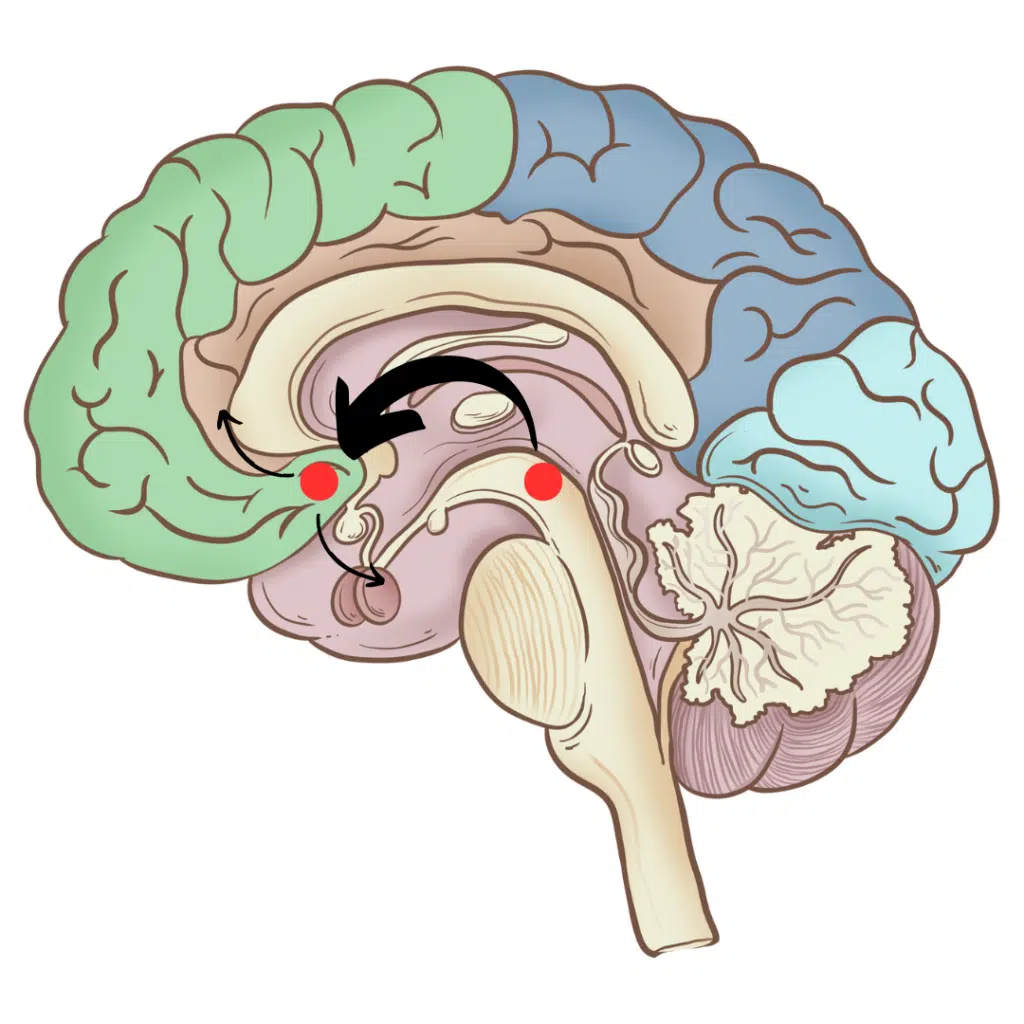What is the brain reward system? It is a fascinating network that influences our motivation, learning, and enjoyment of life. This system, where dopamine plays a key role, not only rewards us for positive experiences but also motivates us to repeat these moments. But how exactly does it work? And why can it become a problem when overstimulated? Discover how the brain reward system functions and how you can consciously influence it to lead a more balanced life.
What is the Brain Reward System?
The human brain has a complex reward system embedded deeply within cortical and subcortical structures. It governs our motivation, regulates learning through positive reinforcement, and is essential for experiencing joy and pleasure.
Reward Centers in the Brain
Rather than a single reward center, the brain reward system consists of various structures that interact with each other. The mesolimbic system is a central player in this interaction.
The Mesolimbic Pathway and Nucleus Accumbens
The mesolimbic pathway links the midbrain with the limbic system, tracing a route from the ventral tegmental area (VTA) to several limbic structures, primarily the nucleus accumbens.
Here’s a simplified overview: when we experience a positive or desirable stimulus, dopamine is released in the VTA and travels along the mesolimbic pathway to the nucleus accumbens, triggering a sensation of happiness. From there, dopamine moves to other brain areas via the mesolimbic system.
Research has shown that dopamine can be released even in anticipation of a reward, motivating us to repeat certain actions.

The Dopaminergic Reward System
Dopamine and Its Function
Dopamine is a neurotransmitter, meaning it moves between areas of the brain to trigger certain reactions. We often associate dopamine with pleasure and reward, yet it operates across four major signaling systems.
- The most well-known is the mesolimbic system, which governs our motivation and emotions.
- Second comes the mesocortical system, which is responsible for perception, decision-making, and short-term memory.
- The nigrostriatal system controls body movements.
- Finally, the tuberoinfundibular system regulates hormones and nurturing behaviors.
Dopamine Reward Pathway and Dopaminergic Action: Addiction
Typical dopamine release supports our everyday lives; for example, we feel good when we’re full, which motivates us to eat regularly. Certain substances like alcohol, nicotine, (meth)amphetamine, cocaine, and heroin are thought to overstimulate the mesolimbic system, leading to a dopamine surge. This surge can cause feelings of intense pleasure, even euphoria. Since dopamine is also released in anticipation, we’re motivated to repeat the experience.
However, when the mesolimbic system is overstimulated regularly, the brain adapts by reducing the number of dopamine receptors, which means higher amounts of the substance are needed to achieve the same effect, while normal dopamine releases seem dull. Over time, this leads to addiction, as everyday activities lose appeal, leaving only the stimulus as a source of happiness.
Not only substances but also certain activities can have addictive potential. When small dopamine releases occur in short succession, for example social media scrolling, they add up to a larger dopamine surge that becomes increasingly desirable.
Willful Manipulation of the Reward System
Strategies to Influence the Brain Reward System
It is possible to reprogram your brain reward system with some specific techniques, though it won’t happen overnight, as the brain resists giving up familiar reward patterns. In the beginning, perseverance is required.
If you want to enjoy a certain activity more, ensure that the activities immediately before or after it release less dopamine than the desired task.
For instance, if you need to study but first catch up on social media and watch a movie after studying, you’ll feel little motivation for studying. However, if you start studying right after waking up and meditate for ten minutes afterward, studying will produce the largest dopamine release, making it easier to enjoy.
Instead of making other activities less exciting, you can also increase dopamine during the target activity. If you want to jog regularly, try watching a favorite show while on the treadmill. The dopamine released from the show will become unconsciously associated with jogging, increasing your motivation.
Modulating the Dopaminergic Reward System
A well-regulated dopamine level can support emotional well-being, cognitive functions, and self-control. Here are some effective strategies for naturally regulating dopamine levels:

Exercise
Regular physical activity naturally raises dopamine levels without intense peaks. Exercise also helps sensitize dopamine receptors, enhancing dopamine’s long-term effects.
Protein-Rich Diet
Proteins contain amino acids, including tyrosine and phenylalanine, which the body can use to produce dopamine. So adequate intake is essential.
Avoid Saturated Fats
Although mostly observed in animal studies, there’s evidence that saturated fats may disrupt dopamine signaling.
Sleep
Studies show that a lack of sleep reduces available dopamine receptors.
Dopamine Fasting
Try a dopamine detox by avoiding pleasurable activities to refocus on small joys, like appreciating a beautiful flower, thereby re-sensitizing the reward system.
Vitamin D
Daylight exposure, especially in winter, is essential for well-being. Make sure you get enough light to avoid those winter blues.
Music
Don’t underestimate the power of your favorite songs. Studies have found a positive increase in dopamine levels, especially with instrumental music.
Conclusion: The Power of the Brain Reward System and Its Effects on Our Lives
The brain reward system is a central driver of our behavior, directing our desires, controlling our motivation, and tightly linking with our sense of joy. Through dopamine release, it encourages us to repeat pleasurable actions, which can also lead to addiction. However, with conscious management and targeted strategies, we can positively influence the reward system, fostering a healthy balance. Understanding this system gives us the tools to enhance our quality of life and well-being over the long term.




